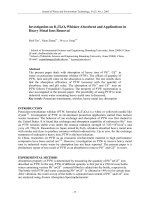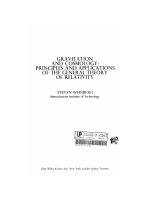Physical chemistry principles and applications in biological sciences (4th edition) by ignacio tinoco jr 1
Bạn đang xem bản rút gọn của tài liệu. Xem và tải ngay bản đầy đủ của tài liệu tại đây (19.32 MB, 100 trang )
PHYSICAL
CHEMISTRY
Principles and Applications in Biological Sciences
FOURTH
EDITION
TINOCO · SAUER · WANG · PUGLISI
Periodic Table of t,fre Elements
1
,,
...
18
lA
-
2
2A
3
f
Li
Be
6Mt
9.ot218
3
4
5
6
7
24.30110
3B
4B
SB
6B
7B
20
21
22
24
2,5
Ca
Sc
Ti
23
39.89113
40.078
4&.9559
3'1
38
39
11
12
Na
Mg
22.-
19
K
Rb
Sr
8U671
87.62 ·
-5$
c.
8A
13 14 15 16 J7
56
8
~8B~
'28
26
27
v
Cr
Mn
Fe
47.88
50.9415
51.9961
54.9381
55.847
40
41
42
43
44
; Co
>'I
58.9332
' '' 45
y
Zr
Nb
·Mo
Tc
Ru~
Rh
88.9059
91.224
92.9064
95.94
(98)
101.67
102.906
57
72
73
74
75
76-
•ta
Hf
Ta
w
Re·
Os
Ir
13'1.321
138.906
178.49
180.948
183.84
186.207
190.23
192.22
89
1M
105
Db
. Sg
107
Rf
Bh
lOs
Hs ·
(261)
(262)
(263)
(262)
(265)
ffl
88
Ra
+Ac
QZ3)
226.025
2%7.628
t Actinide series
-
59
~
Ni
Cu
Zn
58.693
63.546
65.39
46
47
106.42.
107.868
48
78
Cd
112.411 ' 114.818
·80
79
Au
Hg
195.08 ' 196.967
I
(269)
200.59
111
110
I
(272)
81
Tl
112
I
(272)
I,;, .,_
J
(287)
67
I
~
'
I
(289)
Sm
Eu
Gd
65
66
Pm
Tb
Dy
Ho
Er
Tm
Yb
Lu
140.115
140.908
144.2.4
(145)
150.36
151.965
151.25
158.925
162.50
164.930
167.26
168.934
113.04
174.967
90
91
92
93
94
95
96
97
98
99
100
101
102
103
(260)
Pa
232.038
231.036
63
64
68
69
70
Nd
Th
62
2B
Pr
60
61
(2~)
lB
29
Pt
109
Mt
12
Ce
58
*Lanthanide series
106
11
Pd ,. Ag
77
Ba
Fr
10
9
u
Np
Pu
A.Jn
Cm
Bk
Cf
Es
Fm
Md
No
238.1129
237.048
(244)
(243)
(247)
(247)
(251)
(252)
(251)
(258)
(259)
71
Lr
Atomic masses are relative to carbon-1 2. For certain radioactive elements, the numbers listed (in parentheses) are the mass numbers of the most stable isotopes.
The scheme for numbering of groups is explained on page 50. The metals are 1 rand the nonmetals are • · Metalloids are indicated by •· The noble gases are •.
Elements 110, 111, and 112 have not yet been named.
I
Miscellaneous Conversions and Abbreviations
To coavert from:
To:
calories
calories
calories
electron volts
electron volts
electron volts
electron volts
ergs
ergs
ergs molecule- 1
ergs molecule- 1
joules
joules
joules.
joules mol- 1
joules mol- 1
kilowatt-hours
kilowatt-hours
kcal mol- 1
kcal mol- 1
kcal mol- 1
kilojoules moi- 1
kilojoules mol:- 1
kilojoules mol- 1
ergs
joules
kilowatt-hours
kcalmol- 1
ergs
joules
kilojoules mol- 1
calories
joules
joules mol- 1
kcalmol- 1
calories
ergs
kilowatt-hours
ergs molecule-1
kcal mol- 1
calories
joUles
electron volts
ergs molecule- 1
joules mol- 1
electron volts
ergs molecule- 1
kcal mol- 1
Multiply by:
4.184 X
4.184
1.162 X
23.058
1.602 X
1.602 X
96.474
2.390 X
10-7
6.022 X
1.439 X
0.2390
107
2.778 X
1.661 X
2.390 X
8.606 X
3.600 X
0.04337
6.949 X
4.184 X
0.01036
1.661 X
0.2390
107
10- 6
10-12
10- 19
10- 8
1016
1013
10-7
10- 17
10- 4
1(}'i
106
10- 14
103
10- 14
Length
1 angstrom = 10- 10 m
10-8 em
1 inch = 2.54 em
1 foot = 30.48 em
1 mile = 5280 ft = 1609 m
O.lnm
Mass
1 pound = 453.6 g
1 kg = 2.205 pounds
Energy
1 erg = 1 g em2 s- 2
1 joule = 1 kg m 2 s- 2
Force
1 newton = 1 kg m s- 2 = lOS dyn
1 dyne = 1 gems- 2 = 10- 5 N
Pressure
1 atmosphere = 760 mrnHg (Torr.)
1.013 x 106 dyn em-2
1.013 X lOS newton m- 2
1.033 ><-.10' kg-force m- 2
1.013 X lOS pascals
1 newton m- 2 = 1 pascal
14.70 lb in- 2
Power
1 watt= lJs- 1
Volume
1 gallon
1 VA
3.785 L
Viscosity
1 poise (P) = 1 g em- 1 s- 1 = 10- 1 Pas
1 pascal sec (Pas)
1. kg m- 1 s- 1 = 10 P
1 mPas = 1 cP
p
A angstrom
'A
ampere
rad
cal
calorie
V
hertz (Hz) = cycles per second W
hr = hour
y
.•
~
poise
radian
volt
watt
year
l ''
:
FOURTH
EDITION
Physical Chemistry
Principles and Applications in Biological Sciences
Ignacio Tinoco, Jr.
University of California, Berkeley
Kenneth Sauer
University of California, Berkeley
James C. Wang
Harvard University
Joseph D. Puglisi
Stanford University
PrPnt icP
IIall
-Prentice Hall
Upper Saddle River, New Jersey, 07458
QH345 .T56 2002
. .
Physical chemistry : ~nnctp~es and
applications in biologtcal setences
Editor in Chief: John Challice
Senior Marketing Manager: Steve Sartori
Executive Managing Editor: Kathleen Schiaparelli
Assistant Managing Editor: Beth Stu ria
Production Supervision/Composition: G&S Typesetters, Inc.
Assistant Editor: Kristen Kaiser
Art Director: Jayne Conte
Cover Designer: Bruce Kenselaar
Manufacturing Manager: Trudy Pisciotti
Assistant Manufacturing Manager: Michael Bell
Managing Editor, Audio/Video Assets: Grace Hazeldine
Art Editor: Shannon Sims
Art Studio: Prepare, Inc.
Editorial Assistant: Eliana Ortiz
Vice President of Production and Manufacturing: David W. Riccardi
© 2002 by Prentice-Hall, Inc.
Upper Saddle River, New Jersey 07458
All rights reserved. No part of this book may be
reproduced, in any form or by any means,
without permission in writing from the publisher.
Printed in the United States of America
10 9 8
Reprinted with corrections July, 2003.
ISBN 0-13-095943-X
About the Cover: The cover shows the structure of the dimeric protein BmrR from Bacillus subtilis
(purple and red) bound to its target DNA sequence (gold) and a drug called TPSb (bronze) . Such
protein-DNA interactions are common and in fact form the basis for regulation of transcription in
both prokaryotes and eukaryotes. In the presence of the drug, the protein dimer distorts the DNA by
unwinding the central bases of the helix and inducing an approximately 50° bend. This in turn allows
this segment of DNA to be transcribed. Physical biochemists use many of the techniques described in
this book to analyze and understand such intermolecular interactions and the structural features of
these biological systems. Zheleznova-Heldwein, E. E., Brennan, R. G. (2001) "Crystal Structure of the
Transcription Activator BmrR Bound to DNA and a Drug" Nature 409:378-382. Structure rendered by
Jonathan Parrish, University of Alberta.
Pearson Education Ltd., London
Pearson Education Australia Pty., Limited, Sydney
Pearson Education Singapore, Pte. Ltd.
Pearson Education North Asia Ltd., Hong Kong
Pearson Education Canada, Ltd., Toronto
Pearson Educaci6n de Mexico, S.A. de C.V.
Pearson Education-Japan, Tokyo
Pearson Education Malaysia, Pte. Ltd.
CONTENTS
Preface xvn
About the Authors x1x
C HA
T E R
Introduction
C HA
The Human Genome and Beyond 4
Transcription and Translation 6
Ion Channels 10
References 11
Suggested Reading 12
Problem 12
T E R
The First Law:
Energy Is
Conserved
Concepts 15
Applications 16
Energy Conversion and Conservation 16
Systems and Surroundings 17
Energy Exchanges 18
First Law of Thermodynamics 28
Describing the State of a System 29
Variables of State 29
Equations of State 31
Paths Connecting Different States 33
Dependence of the Energy and Enthalpy of a Pure Substance on P, V, and T 36
Relations Between Heat Exchanges and DE and DH 44
Phase Changes 45
Chemical Reactions 47
Heat Effects of Chemical Reactions 47
Temperature Dependence of 11H 50
The Energy Change t1E for a Reaction 51
Standard Enthalpies (or Heats) of Formation 51
Bond Energies 53
Molecular Interpretations of Energy and Enthalpy 56
Summary 57
State Variables 57
Unit Conversions 57
General Equations 57
v
vi
Contents
Pressure-Volume Work Only 58
Solids and Liquids 58
Gases 59
Phase Changes 59
Chemical Reactions 60
Mathematics Needed for Chapter 2 60
References 61
Suggested Reading 61
Problems 61
C HA
T E R
The Second Law:
The Entropy of the
Universe Increases
Concepts 69
Applications 69
Historical Development of the Second Law: The Camot Cycle 69
A New State Function, Entropy 73
The Second Law of Thermodynamics: Entropy Is Not Conserved 75
Molecular Interpretation of Entropy 77
Fluctuations
79
Measurement of Entropy 81
Chemical Reactions 81
Third Law of Thermodynamics 82
Temperature Dependence of Entropy 82
Temperature Dependence of the Entropy Change for a
Chemical Reaction 83
Entropy Change for a Phase Transition 84
Pressure Dependence of Entropy 85
Spontaneous Chemical Reactions 87
Gibbs Free Energy 87
Calculation of Gibbs Free Energy 89
Temperature Dependence of Gibbs Free Energy 91
Pressure Dependence of Gibbs Free Energy 94
Phase Changes 97
Helmholtz Free Energy 97
Noncovalent Reactions 97
Hydrophobic Interactions 100
Proteins and Nucleic Acids 101
Use of Partial Derivatives in Thermodynamics 106
Relations Among Partial Derivatives 107
111
State Variables 111
Unit Conversions 111
Summary
Contents
vii
General Equations 111
llG and a System's Capacity to Do Nonexpansion Work 111
Spontaneous Reactions at Constant T and P 111
Changes in Entropy and Gibbs Free Energy 112
References
113
Suggested Reading 113
Problems
CHA
113
T E R
Free Energy and
Chemical
Equilibria
Concepts 121
Applications 122
Chemical Potential (Partial Molar Gibbs Free Energy)
122
Gibbs Free Energy and the Chemical Potential 122
The Sum Rule for Partial Molar Quantities 123
Chemical Potential and Directionality of Chemical Reaction 123
Reactions of Gases: The Ideal Gas Approximation 125
Dependence of Chemical Potential on Partial Pressures
Equilibrium Constant 127
125
Nonideal Systems 130
O,(g)
Oxidation
Reduction
Activity 130
Standard States 131
Activity Coefficients of Ions
139
The Equilibrium Constant and the Standard Gibbs Free Energies
of the Reactants and Products 141
Calculation of Equilibrium Concentrations: Ideal Solutions 144
Temperature Dependence of the Equilibrium Constant 150
Galvanic Cells 153
Standard Electrode Potentials 156
Concentration Dependence of ~ 158
Biochemical Applications of Thermodynamics 159
Thermodynamics of Metabolism 165
Biological Redox Reactions 170
Double Strand Formation in Nucleic Acids 172
Ionic Effect on Protein-Nucleic Acid Interactions 175
Summary 176
Chemical Potential (Partial Molar Gibbs Free Energy) 176
Standard States and Activities 177
Gibbs Free-Energy Change and Equilibrium Constant for a Chemical Reaction 178
Galvanic Cells 178
viii
Contents
Mathematics Needed for Chapter 4 179
References 179
Suggested Reading 179
Problems 179
CHA
T E R
Free Energy and
Physical Equilibria
Concepts 187
Applications
187
Membranes and Transport 187
Ligand Binding 188
Colligative Properties 188
Phase Equilibria
50.000
40.000
'
IMg-ATPJ
30.000
..
20.{k))
0
10.000
0
0
188
One-Component Systems 189
Boiling Point and Freezing Point 189
Solutions of Two or More Components 193
Equilibrium Dialysis 197
198
The Scatchard Equation
Cooperative Binding and Anticooperative Binding 202
Free Energy of Transfer Between Phases
206
Donnan Effect and Donnan Potential 210
Membranes
213
Lipid Molecules 213
Lipid Bilayers 214
Phase Transitions in Lipids, Bilayers, and Membranes
Surface Tension 218
Surface Free Energy 222
Vapor Pressure and Surface Tension 224
Biological Membranes 225
Active and Passive Transport 227
Colligative Properties 231
Molecular-Weight Determination 239
Vapor-Pressure Lowering 240
Summary 241
Phase Equilibrium 241
Solutions 242
References 244
Suggested Reading 245
Internet 245
Problems 245
216
Contents
CHA
T E R
Molecular Motion
and Transport
Properties
1.0 , - - --
- - - - ; , - - --
--,
Concepts 253
Applications 254
Kinetic Theory 255
Brownian Motion and Random Molecular Motion 255
Velocities of Molecules, Translational Kinetic Energy, and Temperature 256
Maxwell-Boltzmann Distribution of Velocities 261
Molecular Collisions 265
Mean Free Path 266
Diffusion 267
[
0.5
D
0.0 '--0.0
-
-
-
'---0.5
I'm
- ----'
1.0
The Random Walk and Diffusion in a Gas 267
Diffusion Coefficient and Pick's First Law 269
Pick's Second Law 271
Determination of the Diffusion Coefficient 272
Relationship Between the Diffusion Coefficient and the Mean-Square
Displacement 273
Determination of the Diffusion Coefficient by Laser Light Scattering 274
Diffusion Coefficient and Molecular Parameters 275
Solvation 276
Shape Factor 277
Diffusion Coefficients of Random Coils 279
Sedimentation 279
Determination of the Sedimentations Coefficient 281
Standard Sedimentation Coefficient 283
Determination of Molecular Weights from Sedimentation
and Diffusion 285
Determination of Molecular Weights from Sedimentation Equilibrium 285
Density-Gradient Centrifugation 288
Viscosity 289
Measurement of Viscosity 290
Viscosities of Solutions 291
Electrophoresis
291
Gel Electrophoresis 292
DNA Sequencing 293
Double-Stranded DNA 294
DNA Fingerprinting 294
Conformations of Nucleic Acids 296
Pulsed-Field Gel Electrophoresis 297
Protein Molecular Weights 299
Protein Charge 300
Macromolecular Interactions 301
Size and Shape of Macromolecules 301
Summary 302
Kinetic Theory 302
Diffusion 304
ix
x
Contents
Sedimentation 304
Frictional Coefficient and Molecular Parameters 305
Combination of Diffusion and Sedimentation 305
Viscosity 305
Electrophoresis 306
Gel Electrophoresis 306
References 307
Suggested Reading 307
Problems 307
CHA
T E R
Kinetics: Rates of
Chemical
Reactions
Concepts 315
Applications 316
Kinetics 316
Rate Law 318
Order of a Reaction 318
Experimental Rate Data 320
Zero-Order Reactions 321
First-Order Reactions 322
Second-Order Reactions 329
Renaturation of DNA as an Example of a Second-Order Reaction 334
Reactions of Other Orders 338
Determining the Order and Rate Constant of a Reaction 338
Reaction Mechanisms and Rate Laws 341
Parallel Reactions 343
Series Reactions (First Order) 345
Equilibrium and Kinetics 349
Complex Reactions 351
Deducing a Mechanism from Kinetic Data
Time(wecks)
352
Temperature Dependence 354
Transition-State Theory 357
Electron Transfer Reactions: Marcus Theory 360
Ionic Reactions and Salt Effects 362
Isotopes and Stereochemical Properties 363
Very Fast Reactions 365
Relaxation Methods 365
Relaxation Kinetics 366
Diffusion-Controlled Reactions 372
Photochemistry and Photobiology 374
Vision 377
Photosynthesis 378
Surrimary 381
Zero-Order Reactions 381
First-Order Reactions 381
Contents
Second-Order Reactions 382
Temperature Dependence 383
Electron Transfer Reactions: Marcus Theory 385
Relaxation Kinetics 385
Diffusion-Controlled Reactions 386
Absorption of Light 386
Photochemistry 386
Mathematics Needed for Chapter 7 387
References 387
Suggested Reading 388
Problems 388
C HA
T E R
Enzyme Kinetics
Concepts
401
Applications 401
Catalytic Antibodies and RNA Enzymes-Ribozymes 401
Enzyme Kinetics 403
Michaelis-Menten Kinetics 406
--r------
Unca1alyzed
7lkl
Catalase
H,o, - -
:_-:r--~-~,-:- ---->
Skl
Kinetic Data Analysis 409
Two Intermediate Complexes 413
Competition and Inhibition 415
E
Reaction coordinate
Competion 415
Competitive Inhibition 416
Noncompetitive Inhibition 418
Allosteric Effects 419
Single-Molecule Kinetics 422
Summary 423
Typical Enzyme Kinetics 423
Michaelis-Menten Mechanism 424
Monod-Wyman-Changeux Mechanism 425
Mathematics Needed for Chapter 8 425
References 426
Suggested Reading 426
Problems 427
C HA
T E R
Molecular
Structures and
Interactions:
Theory
Concepts 437
Applications 437
The Process of Vision 438
Origins of Quantum Theory 441
Blackbody Radiation 442
Photoelectric Effect 444
xi
xii
Contents
Electrons as Waves 444
Heisenberg Uncertainty Principle 445
Quantum Mechanical Calculations 446
Wave Mechanics and Wavefunctions
446
Schrodinger's Equation 449
Solving Wave Mechanical Problems 451
Outline of wave Mechanical Procedures 452
Particle in a Box 455
Tunneling 463
Simple Harmonic Oscillator 465
Rigid Rotator 468
Hydrogen Atom 469
Electron Distribution 470
Electron Distribution in a Hydrogen Atom 471
Many-Electron Atoms 476
Molecular Orbitals 479
Hybridization 484
Delocalized Orbitals 486
Molecular Structure and Molecular Orbitals 489
Geometry and Stereochemistry 489
Transition Metal Ligation 491
Charge Distributions and Dipole Moments 493
Intermolecular and Intramolecular Forces 493
Bond Stretching and Bond Angle Bending 494
Rotation Around Bonds 495
Noncovalent Interactions 497
Electrostatic Energy and Coulomb's Law 497
Net Atomic Charges and Dipole Moments 500
Dipole-Dipole Interactions 503
London Attraction 505
van der Waals Repulsion 506
London-van der Waals Interaction 507
The Lowest-Energy Conformation 508
Hydrogen Bonds 510
Hydrophobic and Hydrophilic Environments 512
Molecular Dynamics Simulation 514
Monte Carlo Method 514
Molecular Dynamics Method 515
Outlook 516
Summary 517
Photoelectric Effect 517
Wave-Particle Duality 517
Heisenberg Uncertainty Principle 517
Schrodinger's Equation 518
Some Useful Operators 518
Contents
Systems Whose Schrodinger Equation Can Be Solved Exactly 519
Coulomb's Law 521
Dipoles and Their Interaction Energy 521
Intramolecular (Within) and Intermolecular (Between) Interactions 521
Mathematics Needed for Chapter 9
References 523
Suggested Reading 523
Problems 524
C H
1
P
ER
Molecular
Structures and
Interactions:
Spectroscopy
2l0
260
270
Wvvelenglh (nm)
280
Concepts 531
Applications 532
Electromagnetic Spectrum 532
Color and Refractive Index 533
Absorption and Emission of Radiation 535
Radiation-Induced Transitions 536
Classical Oscillators 538
Quantum Mechanical Description 538
Lifetimes and Line Width 540
Role of Environment in Electronic Absorption Spectra 541
Beer-Lambert Law 543
Proteins and Nucleic Acids: Ultraviolet Absorption Spectra
Amino Acid Spectra 549
Polypeptide Spectra 549
Secondary Structure 551
Origin of Spectroscopic Changes 551
Nucleic Acids 552
Rhodopsin: A Chromorphic Protein 553
Fluorescence 554
Simple Theory 555
Excited-State Properties 556
Fluorescence Quenching 560
Excitation Transfer 561
Molecular Rulers 563
Fluorescence Polarization 564
Phosphorescence 565
Single-Molecule Fluorescence Spectroscopy 565
Optical Rotatory Dispersion and Circular Dichroism 567
Polarized Light 568
Optical Rotation 571
Circular Dichroism 573
Circular Dichroism of Nucleic Acids and Proteins 573
548
xiii
xiv
Contents
Vibrational Spectra, Infrared Absorption, and Raman Scattering 576
Infrared Absorption 576
Raman Scattering 577
Nuclear Magnetic Resonance 579
The Spectrum 581
Interactions in Nuclear Magnetic Resonance
583
Chemical Shifts 583
Spin-Spin Coupling, Scalar Coupling, or J-Coupling 585
Relaxation Mechanisms 588
Nuclear Overhauser Effect 590
Multidimensional NMR Spectroscopy 590
Determination of Macromolecular Structure by Nuclear Magnetic Resonance 594
Electron Paramagnetic Resonance 596
Magnetic Resonance Imaging 597
Summary 598
Absorption and Emission 598
Excitation Transfer 600
Optical Rotatory Dispersion and Circular Dichroism 600
Nuclear Magnetic Resonance 600
References 601
Suggested Reading
Problems 603
C H
601
E R
Molecular
Distributions and
Statistical
Thermodynamics
Concepts 615
Applications 615
Binding of Small Molecules by a Polymer 616
Identical-and-Independent-Sites Model 617
Langmuir Adsorption Isotherm 619
Nearest-Neighbor Interactions and Statistical Weights 620
Cooperative Binding, Anticooperative Binding, and Excluded-Site Binding 622
N Identical Sites in a Linear Array with Nearest-Neighbor Interactions 625
Identical Sites in Nonlinear Arrays with Nearest-Neighbor Interactions 626
The Random Walk 628
Calculation of Some Mean Values for the Random-Walk Problem
Diffusion 634
Average Dimension of a Linear Polymer 634
Helix-Coil Transitions
636
Helix-Coil Transition in a Polypeptide 636
Helix-Coil Transition in a Double-Stranded Nucleic Acid
Statistical Thermodynamics 645
Statistical Mechanic Internal Energy 646
Work 647
Heat 648
641
630
Contents
Most Probable (Boltzmann) Distribution 649
Quantum Mechanical Distributions 653
Statistical Mechanical Entropy 653
Examples of Entropy and Probability 654
Partition Function: Applications 658
Summary 659
Binding of Small Molecules by a Polymer 659
Random-Walk and Related Topics 660
Helix-Coil Transitions 660
Statistical Thermodynamics 661
Mathematics Needed for Chapter 11
References 662
Suggested Reading 663
Problems 663
C H
662
E R
Macromolecular
Structure and
X-Ray Diffraction
Concepts 667
Applications 667
Visible Images 668
X Rays 668
Emission of X Rays 669
Image Formation 669
Scattering of X Rays 670
Diffraction of X Rays by a Crystal 675
Measuring the Diffraction Pattern 678
Bragg Reflection of X Rays 679
Intensity of Diffraction 681
Unit Cell 683
Determination of Molecular Structure 684
Calculation of Diffracted Intensities from Atomic
Coordinates: The Structure Factor 684
Calculation of Atomic Coordinates from Diffracted
Intensities 686
The Phase Problem 688
Direct Methods 688
Isomorphous Replacement 688
Multiwavelength Anomalous Diffraction 690
Determination of a Crystal Structure 691
Scattering of X Rays by Noncrystalline Materials 694
Absorption of X Rays 695
\
Extended Fine Structure of Edge Absorption 696
X Rays from Synchrotron Radiation 697
Electron Diffraction 698
Neutron Diffraction 699
xv
xvi
Contents
Electron Microscopy
700
Resolution, Contrast, and Radiation Damage 700
Transmission and Scanning Electron Microscopes 701
Image Enhancement and Reconstruction 701
Scanning Tunneling and Atomic Force Microscopy 702
Summary 704
X-ray Diffraction 704
Neutron Diffraction 707
Electron Microscopy 707
Mathematics Needed for Chapter 12 707
References 708
Suggested Reading 708
Problems 709
Appendix 712
Answers 725
Index 728
P.REFAC E
T
here is a deep sense of pleasure to be experienced when the patterns and
symmetry of nature are revealed. Physical chemistry provides the methods to discover and understand these patterns. We think that not only is it important to learn and apply physical chemistry to biological problems, it may
even be fun. In this book, we have tried to capture some of the excitement of
making new discoveries and finding answers to fundamental questions.
This is not an encyclopedia of physical chemistry. Rather, we have written this text specifically with the life-science student in mind. We present a
streamlined treatment that covers the core aspects of biophysical chemistry
(thermodynamics and kinetics as well as quantum mechanics, spectroscopy,
and X-ray diffraction), which are of great importance to students of biology
and biochemistry. Essentially all applications of the concepts are to systems
of interest to life-science students; nearly all the problems apply to life-science
examples.
For this fourth edition we are joined by Joseph Puglisi, a new, young author who strengthens the structural biology content of the book. We have also
tried to make the book more reader-friendly. In particular, we omit fewer
steps in the explanations to make the material more understandable, and we
have followed the many helpful and specific recommendations of our reviewers to improve the writing throughout. Important new topics, such as
single-molecule thermodynamics, kinetics, and spectroscopy, are introduced.
Subjects that have become less pertinent to current biophysical chemistry
have been deleted or de-emphasized. Reference lists for each chapter have
been updated. However, the format and organization of the book is essentially unchanged.
Chapter 1 introduces representative areas of active current research in
biophysical chemistry and molecular biology: the human genome, the transfer of genetic information from DNA to RNA to protein, ion channels, and
cell-to-cell communication. We encourage students to read the current literature to see how the vocabulary and concepts of physical chemistry are used
in solving biological problems.
Chapters 2 through 5 cover the laws of thermodynamics and their applications to chemical reactions and physical processes. Essentially all of the
examples and problems deal with biochemical and biological systems. For
example, after defining work as a force multiplied by the distance moved
(the displacement), we discuss the experimental measurement of the work
necessary to stretch a single DNA molecule from its random-coiled form to
an extended rod. Molecular interpretations of energies and entropies are emphasized in each of the chapters. Chapter 4, "Free Energy and Chemical Equilibria," now starts with the application of the chemical potential to chemical
reactions. We think that this will make it easier to understand the logic relating activities and equilibrium constants to free energy. Binding of ligands
and equilibria between phases are described in chapter 5, "Free Energy and
Physical Equilibria." We discuss in detail the allosteric effect and the cooperative binding of oxygen by hemoglobin. We also describe the formation of
lipid monolayers, lipid bilayers, and micelles, and their structures are compared to biological membranes.
xvii
xviii
Preface
Chapters 6 through 8 cover molecular motion and chemical kinetics.
Chapter 6, "Molecular Motion and Transport Properties," starts with the
Brownian motion on an aqueous surface of a single lipid molecule labeled
with a fluorescent dye. The random motion of the molecule can be followed
to test Einstein's equation relating average distance traveled by a single molecule to a bulk diffusion coefficient. Following this direct experimental demonstration of thermal motion of a molecule, we introduce the kinetic theory of
gases and discuss transport properties (diffusion, sedimentation, and electrophoresis) of macromolecules. The next two chapters deal with general
chemical kinetics and enzyme kinetics. New topics include Marcus's theory
of charge-transfer reactions, allosteric effects in enzyme kinetics, and singlemolecule enzyme kinetics.
Chapter 9, "Molecular Structures and Interactions: Theory," has been rearranged to begin with the origins of the quantum theory, continue through
quantum mechanics of simple models, and, finally, discuss the semi-empirical
methods applied to macromolecules. This logical progression should make it
easier for students to understand and appreciate the applications of quantum mechanics to macromolecular structure. In chapter 10 we emphasize absorption, fluorescence, and nuclear magnetic resonance-the spectroscopic
methods most used in structural biology.
In chapter 11, "Molecular Distributions and Statistical Thermodynamics," we present a detailed discussion of the effect of cooperativity or anticooperativity on the binding of successive ligands.
Chapter 12 discusses X-ray diffraction, electron microscopy, and scanning microscopies (such as atomic force microscopy), and emphasizes how
structures are determined experimentally. We describe the many methods
used to solve the phase problem in X-ray diffraction-including MAD, multiwavelength anomalous diffraction.
The problems have been revised and checked for clarity and the answers
in the back of the book and in the solutions manual have been checked for
accuracy. We thank Christopher Ackerson, Ruben Gonzalez, Michael Sykes,
and Anne Roberts for checking the problems.
We are gratified by the number of faculty who have elected to use this
book over the many years since it was first published. We are also grateful
for the many students and faculty who have given us their thoughts and impressions. Such feedback has helped improve the book from edition to edition. We are particularly grateful to those of our colleagues who commented
on the third edition, reviewed the manuscript for this edition, and checked
our manuscript for accuracy: Fritz Allen, University of Minnesota; Carey
Bagdassarian, College of William and Mary; Wallace Brey, University of Florida; Mark Britt, Baylor University; Kuang Yu Chen, Rutgers University; GeraldS. Harbison, University of Nebraska-Lincoln; Roger Koeppel, University
of Arkansas; Philip Reiger, Brown University; Gianluigi Veglia, University of
Minnesota; and Danny Yeager, Texas A&M University.
We welcome your comments.
Ignacio Tinoco, Jr.
Kenneth Sauer
James C. Wang
Joseph D. Puglisi
ABOUT T H E AUTHORS
I
gnacio Tinoco was an undergraduate at the University of New Mexico, a
graduate student at the University of Wisconsin, and a postdoctoral fellow
at Yale. He then went to the University of California, Berkeley, where he has
remained. His research interest has been on the structures of nucleic acids,
particularly RNA. He was chairman of the Department of Energy committee
that recommended in 1987 a major initiative to sequence the human genome.
His present research is on unfolding single RNA molecules by force.
K
enneth Sauer grew up in Cleveland, Ohio, and received his A.B. in
chemistry from Oberlin College. Following his Ph.D. studies in gasphase physical chemistry at Harvard, he spent three years teaching at the
American University of Beirut, Lebanon. A postdoctoral opportunity to
learn from Melvin Calvin about photosynthesis in plants led him to the University of California, Berkeley, where he has been since 1960. Teaching general chemistry and biophysical chemistry in the Chemistry Department has
complemented research in the Physical Biosciences Division of the Lawrence
Berkeley National Lab involving spectroscopic studies of photosynthetic
light reactions and their role in water oxidation. His other activities include
reading, renaissance and baroque choral music, canoeing, and exploring the
Sierra Nevada with his family and friends.
!
ames C. Wang was on the faculty of the University of California, Berkeley,
from 1966 to 1977. He then joined the faculty of Harvard University, where
e is presently Mallinckrodt Professor of Biochemistry and Molecular Biology. His research focuses on DNA and enzymes that act on DNA, especially a
class of enzymes known as DNA topoisomerases. He has taught courses in
biophysical chemistry and molecular biology and has published over 200 research articles. He is a member of Academia Sinica, the American Academy
of Arts and Sciences, and the U.S. National Academy of Sciences.
J
oseph Puglisi was born and raised in New Jersey. He received his B.A. in
chemistry from The Johns Hopkins University in 1984 and his Ph.D. from
the University of California, Berkeley, in 1989. He has studied and taught in
Strasbourg, Boston, and Santa Cruz, and is currently professor of structural
biology at Stanford University. His research interests are in the structure and
mechanism of the ribosome and the use of NMR spectroscopy to study RNA
structure. He has been a Dreyfus Scholar, Sloan Scholar, and Packard Fellow.
xix
Physical Chemistry
Principles and Applications in Biological Sciences
CHAPTER
cell exterior
cell interior
Introduction
P
hysical chemistry is everywhere. Physical chemical principles
are basic to the methods used to determine the sequence of
the human genome, obtain atomic resolution structures of proteins and nucleic acids, and learn how biochemicals react and
interact to make a cell function.
Physical chemistry is a set of principles and experimental methods for exploring chemical systems. The power of physical chemistry lies in its generality.
The principles described in this book can be applied to systems as large as
the cosmos and as small as an individual atom. Physical chemistry has been
especially powerful in understanding fundamental biological processes. In
the following chapters, we will present the principles of thermodynamics,
transport properties, kinetics, quantum mechanics and molecular interactions, spectroscopy, and scattering and diffraction. We will also discuss various experimentally measurable properties such as enthalpy, electrophoretic
mobility, light absorption, and X-ray diffraction. All these experimental and
theoretical methods give useful information about the part of the universe
in which you are interested. We emphasize the molecular interpretation of
these methods and stress biochemical and biological applications. By learning the principles behind the methods, you will be able to judge the conclusions obtained from them. This is the first step in inventing new methods or
discovering new concepts.
First, a quick tour of the book Chapters 2 through 5 cover the fundamentals of thermodynamics and their applications to chemical reactions and
physical processes. Because these chapters review material usually covered
in beginning chemistry courses, we emphasize the applications to biological
macromolecules. Chapter 6 covers transport properties and describes the effect
of sizes and shapes of molecules on their motions in gases, liquids, and gels.
The driving forces for molecUlar motion are either random thermal forces that
cause diffusion or the directed forces in sedimentation, flow, and electrophoresis. Chapter 7 describes general kinetics, and chapter 8 concentrates on the
kinetics of enzyme-catalyzed reactions. Chapter 9, which deals with molecular
structures and intermolecular interactions, introduces the quantum mechanical principles necessary for understanding bonding and spectroscopy, and describes calculations of protein and nucleic acid conformations using classical
force fields (Coulomb's law, van der Waals' potential). Chapter 10 includes the
main spectroscopic methods used for studying molecules in solution: ultraviolet, visible, and infrared absorption; fluorescence emission; circular dichroism
and optical rotatory dispersion; and nuclear magnetic resonance. Chapter 11
introduces the principles of statistical thermodynamics and describes their biochemical applications. Topics such as helix-coil transitions in polypeptides (proteins) and polynucleotides (nucleic acids) and the binding of small molecules
to macromolecules are emphasized. Chapter 12 starts with the scattering of electromagnetic radiation from one electron and proceeds through the diffraction
of X rays by crystals. Scanning microscope methods are introduced. The appendix contains numerical data used throughout the book, unit conversion tables,
and the structures of many of the biological molecules mentioned in the text.
We encourage you to consult other books for background information
and further depth of coverage. Standard physical chemistry texts offer applications of physical chemistry to other areas. Biochemistry and molecular biology texts can provide specific information about such areas as protein and
nucleic acid structures, enzyme mechanisms, and metabolic pathways. Finally, a good physics textbook is useful for learning or reviewing the fundamentals of forces, charges, electromagnetic fields, and energy. A list of
such books is given at the end of this chapter.
3









